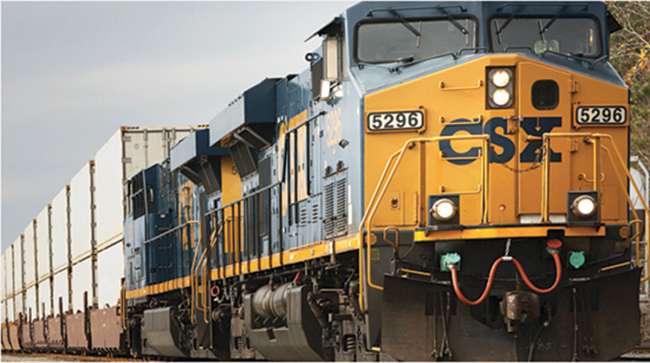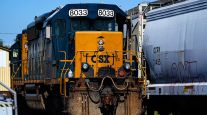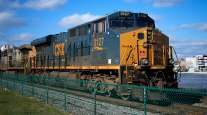Senior Reporter
CSX Beats Expectations With Q2 Freight Surge

[Stay on top of transportation news: Get TTNews in your inbox.]
Jacksonville, Fla.-based CSX Corp. reported second-quarter earnings that showed a strong uptick in freight shipments, and the company’s financial picture exceeded Wall Street analysts’ expectations.
Net income was $1.17 billion, or 52 cents per share, compared with $499 million, 22 cents, in the same period a year ago.
The Class I railroad said quarterly revenue increased 33% year-over-year to $2.99 billion, compared with $2.25 billion, driven by growth across all lines of business as well as the sale of property rights of rail segments in Virginia.
$CSX is positioned for growth – relentlessly focused on delivering high quality service and supply chain solutions that enable customers to meet their business needs and growth targets. Learn more: Download the $CSX Q2 2021 performance materials at https://t.co/sJsb55YzuC pic.twitter.com/S7BpNz8QbJ — CSX (@CSX) July 21, 2021
Earlier this year, CSX reached a $525 million rail agreement with the Commonwealth of Virginia as part of a planned multibillion-dollar rail transportation initiative to upgrade service and infrastructure in the state. In the second quarter, the sale added $349 million in income to the railroad’s finances.
CSX’s operating ratio improved to 43.4 compared with 63.3 in the prior-year period. The rail segment sale helped boost the operating ratio by 11.7 percentage points.
Operating ratio, or operating expenses as a percentage of revenue, is used to measure efficiency. The lower the ratio, the higher the company’s ability to generate profit.

Foote
“This quarter’s results highlighted just how quickly volumes rebounded as each of our lines of business recorded record growth. I want to thank all the CSX railroaders for their dedicated and unwavering focus on our customers as the economy has rebounded,” CEO James Foote said. “We are committed to providing customers a high-quality service product and will continue taking all necessary steps to meet their needs.”
The average from 26 analysts polled by Yahoo Finance was for the railroad’s quarterly share price to come in at 36 cents per share, well below the 52 cents per share that CSX reported.
Transportation and industrial analyst Jeff Windau with Edward Jones told Transport Topics he was impressed with the railroad’s overall performance, even without the railroad getting a considerable bump from the track sale in Virginia.
“It was definitely a really strong quarter, with excellent execution,” he said. “The headline numbers were breathtaking; even taking into account the real estate sale, which we do, they still have excellent numbers. Overall, it was a very solid performance.”
Revenue and volume across all of the railroad’s business sectors showed significant year-over-year improvement.
Chemical shipment revenue increased 14% to $606 million from $531 million.
Agriculture and food shipments rose 19% to $370 million from $311 million.
Mineral shipments increased 13% to $152 million from $134 million.
The automotive sector saw a 132% increase to $216 million from $93 million.
Forest products increased 18% to $233 million from $197 million.
Metals and equipment notched upward 44% to $204 million from $142 million.
Fertilizer shipments rose 22% to $122 million from $100 million.
Intermodal revenue increased 42% to $511 million from $359 million.
Coal revenue jumped 47% to $423 million from $287 million.
Other revenue increased by 51% to $151 million from $101 million.
CSX said auto-shipments were up 120% year-over-year because of the increasing demand for new and used vehicles, and, in 2020, automobile factories closed because of the COVID-19 pandemic.
Metal, forest products and mineral shipments were up because of the surge in housing construction and remodeling.

Could this be the trucking industry’s roaring '20s? Business is booming, thanks, in part, to a slew of innovative technologies. With host Mike Freeze, we begin to wonder what’s next? Hear a snippet above, and get the full program by going to RoadSigns.TTNews.com.
After several consecutive quarters of reducing the number of employees needed to run the railroad, CSX saw its end-of-quarter head count increase by 325 employees to 19,181 workers, compared with 18,856 a year ago.
On a conference call with analysts after the earnings announcement, company officials acknowledged that the railroad is hiring with freight volumes increasing. However, like the trucking industry, which has a driver shortage, it has been challenging to find employees.
“In January, when I got on this call, I said we were hiring because we anticipated growth. I fully expected we would have 500 new employees on the property,” Foote said. “No way did I, or anybody else, realize how difficult it would be to get people to come to work these days. It is an enormous challenge to find people that want to be conductors on the railroad. It’s very difficult.”
Foote said the challenge to hiring is that railroading is 24 hours a day, seven days a week all year.
Windau said the entire transportation sector is struggling to recruit workers.
“It caught me a bit by surprise, but across all industries, we’ve been seeing those challenges of hiring people,” Windau said. “We expect some volume growth as we continue to progress through the year and we need to make sure that we can keep the trains running and keep the network fluid.”
Want more news? Listen to today's daily briefing below or go here for more info:




